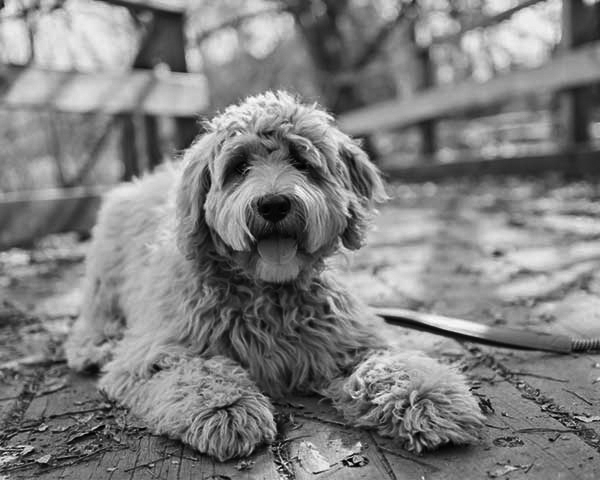Labradoodle dog breed information and advice
Labradoodle puppies and dogs are one of the most popular mixed-breeds and have swept into the hearts of dog lovers everywhere. Their cute coats and playful personalities have made this dog breed a popular choice for families. Plus, if the pup has inherited the coat of a poodle, they can also be a good choice for allergy sufferers.
As the name suggests, the Labradoodle was born from breeding a Labrador with a Poodle.
The Labradoodle size and weight depend on the parents, and whether a toy, miniature or standard Poodle was used in the breeding.
Here’s your go-to Labradoodle dog breed guide with facts and care tips to help keep your pup in tip top shape.
Labradoodle facts

| Lifespan | 12 - 15 years |
| How much | £600 - £3000 |
| Size | there are three size variation varying between 36 - 61cm |
| Weight | 7 - 30 kg depending on if they are miniture |
| Colours | caramel, chocolate, cream, golden/apricot, parchment, red, chalk, black, silver, blue, lavender, phantom |
| Grooming | may need clipping 6 - 8 weeks depending on brushing |
| Temperament | intelligent, affectionate, excitable |
| Exercise | one to two hours a day |
Labradoodle insurance
Dog insurance for your Labradoodle will give you peace of mind when it comes to providing healthcare for your pet. Even the healthiest of dogs can have an unexpected tumble, so it’s good to know that their dog insurance can help when it comes to vet bills, illness or injury.
Having dog insurance for your Labradoodle ensures your pup can get the help they need and could come in handy to help pay for conditions like:
Sainsbury’s Bank Pet Insurance
Sainsbury’s Bank Pet Insurance can protect your Labradoodle puppies from as young as eight weeks old.
Dog insurance from Sainsbury’s Bank can protect your Labradoodle puppy to keep their tails wagging and your wallet happy. You can choose between:
- Lifetime Cover – the most comprehensive option and may include vet cost cover between £2,500 and £10,000 a year for ongoing issues, depending on the cover you choose.
- Maximum Benefit – your pet will be covered for accidents and illnesses up to your policy limits. The condition will be covered until the limit runs out.
- Time Limited – with this cover you can claim for different treatments throughout the year, up to a maximum of £3,000.
All insurance policies have restrictions. To find out more about our terms and conditions including exclusions, excesses and limits, please take a look at our policy documents.
How to care for a Labradoodle
While it’s easy to get caught up in the excitement of taking your Labradoodle puppy home, it’s important to know how to care for them to keep them happy and healthy. You need to understand their diet, exercise, grooming and training requirements as this will affect their Labradoodle temperament and behaviour.
Feeding and nutrition
The amount of food your dog needs depends on its size. Labradoodle size varies, depending on if they have been bred with a miniature or standard poodle. This means they need a diet to match. Generally, dog food is portioned depending on the dog’s size. You can check the food packaging to find out how much they should be eating.
A Labradoodle puppy should be fed three to four times a day. As they grow into an adult, this can decrease to one to two times a day.
Here are a few things to consider when it comes to feeding your Labradoodle:
- Mini Labradoodles prefer to be fed twice daily. Small dogs prefer smaller portions more frequently to suit their little stomachs.
- Standard Labradoodles would also benefit more from two meals instead of one, as it helps to prevent any stomach issues.
- If a dog eats a lot of food and exercises too soon before or afterward, it can cause their stomach to twist. This is a serious condition so should be avoided by not exercising your dog too close to mealtimes. Try to wait at least an hour after a meal before taking them for a walk.
- Weighing your Labradoodle’s food will make sure they are getting the right portion for their size and will help you control your dog’s weight.
Grooming
Labradoodle shedding is minimal, and their fur is curly, so their grooming needs are fairly low maintenance. If your dog has a short coat, it may need clipping every six to eight weeks, alongside regular brushing. This will depend on your personal preference and the thickness and curliness of their fur.
Labradoodles are considered a hypoallergenic dog breed because of their low shedding, which may make them a good breed choice for dog allergy sufferers.
Exercise
Walking your dog is the best form of exercise, especially if they have some time off lead. But make sure your dog is only let off its lead in a secure area. Labradoodles have lots of energy and are very playful, so need one to two hours of exercise every day to burn off all that energy.
Beware, if your Labradoodle doesn’t get the exercise it needs, it may display behaviour such as chewing, barking or running around the house. Exercise also helps to keep them at a healthy weight. Most Labradoodles love to play and are good at fetch, probably due to the Labrador energy in them. This is a great way to get some additional exercise.
Training
Both Labradors and Poodles are intelligent breeds, meaning that Labradoodles are too. This makes training them easy, although they can get distracted. They have a lot of energy and need to be kept interested in what they’re learning. Use toys or treats to reward them, making the training fun and enjoyable for both dog and trainer.
Training classes are a great way to socialise your pet and to pick up training tips. Labradoodle puppies should start toilet training from the first day you bring them home. House training is simple if you give your dog lots of chances to go to the toilet in the designated toileting area. Always praise and reward your dog when they go to the toilet in the right place.
Temperament and behaviour
Labradoodles have a lively personality no matter what size they are. The Labradoodle temperament makes them ideal pets for any age, but they are best suited to those who have the time to meet their exercise demands. They can display bad behaviour if they haven’t been able to release energy.
Common health problems
There aren't many health problems that are common in crossbreeds. While there is a possibility that they'll develop an issue that is common in the parent breeds, but it’s unlikely unless both parents are predisposed to that condition.
To make sure your Labradoodle has access to the help and care they need should a problem develop, it’s worth considering pet insurance.
Dental problems are common in all dog breeds, so you should brush your dog’s teeth daily to reduce plaque build-up. Take your dog for regular vet health checks so they can pick up on any health care needs before they become a problem.
Below are the main conditions that you should keep an eye out for, which are common in both Labradors and Poodles.
Hip dysplasia
This is an inherited condition that typically affects medium and large dog breeds, causing instability of the hip joint. Affected dogs will experience pain and lameness, and develop arthritis in later life. The condition is a result of the ball-and-socket joint not fitting together properly, causing it to rub and damage the surface of the joint. Diet, growth rate and level of exercise can all affect the severity of this condition. Pain medication can be given to manage the pain, but in severe cases, surgery is the only treatment option.
Progressive retinal atrophy (PRA)
PRA is a group of inherited eye diseases, which are untreatable and will eventually lead to blindness. It’s most commonly seen in miniature and toy Poodles, as well as Labradors. Affected dogs gradually lose their sight; early signs being poor vision at night or in dimly lit conditions. Your Labradoodle may show signs of being nervous when there is poor lighting.
Dogs are typically affected by PRA when they are between three and eight years old, but it can take months to years for complete blindness to happen. Fortunately, many dogs adapt well to being blind and can continue to live long happy lives.
Is a Labradoodle right for you?
A Labradoodle puppy is perfect for you if you’re looking for a loving and energetic addition to your family. Labradoodles are suited to owners who like to spend time outdoors and have lots of love to give. With minimal health conditions and pet insurance to cover your dog if needed, there is little to worry about with this breed.
Frequently asked questions
Do Labradoodles shed?
Labradoodles are generally low-shedders due to them having the curly coat of a Poodle. This makes them a good breed choice for those that suffer from dog allergies. Although no dog breed is completely hypoallergenic, low shedders are less likely to cause a reaction for allergy sufferers.
Is a Labradoodle a good family dog?
The Labradoodle temperament is lovely and friendly, making them perfect dogs for a family home. They have lots of energy and are very playful, making them great with children. Labradoodles need an active home, where they can get exercise every day.
Can Labradoodles be left alone?
Labradoodles are a social breed but can occasionally be left alone for up to eight hours. Labradoodle puppies need more attentive care and shouldn’t be alone for over two hours until they are older than six months.
How long do Labradoodles live?
Labradoodles have a life expectancy of 12-15 years. In general, small dogs live longer than larger dogs, so Miniature Labradoodles and Medium Labradoodles tend to live longer than the standard. Health conditions can affect a dog’s lifespan so make sure your dog receives the health care that it needs. Overweight and underweight dogs are more prone to health conditions.
How big do Labradoodles get?
The size of your Labradoodle depends on whether it was bred with a standard, toy or miniature Poodle. A standard will reach between 56-61 cm in height; a medium will be between 46-51 cm and a Mini Labradoodle will be between 36-41 cm. Their weight will also vary between 7-30kg, with a smaller dog being at the lower end of the scale

Browse our guides
Choose from our list of helpful guides and information

Explore dog breeds
Find out how to keep your dog healthy and happy

Cat breed guides
How to care for your cat, common health problems and more
References
Content provided from Vetstream's Vetlexicon Canis - www.vetstream.com/treat/canis 
Keizer R J & Llewellyn-Zaidi A (online) Retriever: Labrador. In: Vetlexicon Canis. Vetstream Ltd, UK. Website: https://www.vetstream.com/treat/canis/breeds-pages/retriever-labrador 
Vetstream ltd (online) Poodle: Toy. In: Vetlexicon Canis. Vetstream Ltd, UK. Website: https://www.vetstream.com/treat/canis/breeds-pages/poodle-toy 
Vetstream ltd (online) Poodle: Standard. In: Vetlexicon Canis. Vetstream Ltd, UK. Website: https://www.vetstream.com/treat/canis/breeds-pages/poodle-standard 
Vetstream ltd (online) Poodle: Miniature. In: Vetlexicon Canis. Vetstream Ltd, UK. Website: https://www.vetstream.com/treat/canis/breeds-pages/poodle-miniature 
Brooks D E, Williams D L & Gould D (online) Retina: generalized progressive retinal atrophy. In: Vetlexicon Canis. Vetstream Ltd, UK. Website: https://www.vetstream.com/clinical-reference/canis/diseases/retina-generalized-progressive-retinal-atrophy 
Vetstream Ltd (online) Progressive retinal atrophy (PRA) Owner Factsheet. In: Vetlexicon Canis. Vetstream Ltd, UK. Website: https://www.vetstream.com/clinical-reference/canis/owner-factsheets/progessive-retinal-atrophy-(pra) 
Harari J & Langley-Hobbs S (online) Hip: dysplasia. In: Vetlexicon Canis. Vetstream Ltd, UK. Website: https://www.vetstream.com/clinical-reference/canis/diseases/hip-dysplasia 
Vetstream Ltd (online) Hip dysplasia Owner Factsheet. In: Vetlexicon Canis. Vetstream Ltd, UK. Website: https://www.vetstream.com/clinical-reference/canis/owner-factsheets/hip-dysplasia 
Terms and conditions
Important information
* The discount is based on information related to you and the Sainsbury’s and Sainsbury’s Bank transactions linked to your Nectar account. For more information on how we use your data, go to sainsburysbank.co.uk/privacy
Sainsbury's Bank plc, Registered Office, 33 Charterhouse Street, London, EC1M 6HA (registered in England and Wales, no 3279730) is authorised by the Prudential Regulation Authority and regulated by the Financial Conduct Authority and the Prudential Regulation Authority (register no. 184514).
Sainsbury's Supermarkets Ltd is an appointed representative of Sainsbury's Bank plc. Sainsbury's Bank plc acts as an introducer to Pinnacle Insurance Ltd who is authorised by the Prudential Regulation Authority and regulated by the Financial Conduct Authority and the Prudential Regulation Authority (register number 110866). Registered office: 4th Floor, Limelight, Elstree Way, Borehamwood, Hertfordshire, WD6 1JH. Sainsbury’s Bank Pet Insurance is arranged, administered and underwritten by Pinnacle Insurance Ltd. Sainsbury's Bank plc and Pinnacle Insurance Ltd are not part of the same corporate group.
We do not provide personal recommendations to customers.
